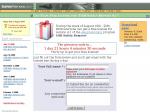Free licenses (worth US$20) being given away until 2pm this Wednesday AEST.
Just fill in your details and they will email you the license key (limit 1 email per IP).
Description from their website:
The main disadvantage of using built-in Windows safe removal tool is that in case of having several hot-plug devices it is quite difficult to recognize a needed to stop device - the most devices have the same name - "USB mass storage device". In addition, Windows does not let you hide a device you would not want to stop from the menu.
USB Safely Remove saves you from these problems and offers an original and multifunctional stopping menu, which displays actual device names with icons. Using this menu you can find and stop a device in a snap!
I was looking for a faster and better way to eject USB devices in Windows and came across this promo.
They also won a PC World magazine 100 Best Products of 2008 Award.


I don't see a use for this.. The way I eject my USB drive is by unplugging it.